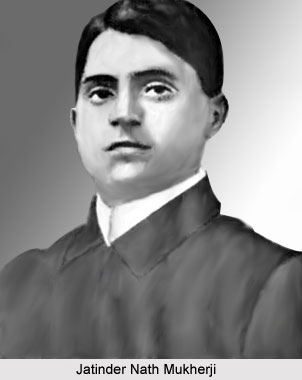 Patriot Jatinder Nath Mukherji alias Jatin Mukherji was one of the well-known leaders of revolutionaries operating in Bengal. His group had introduced a new feature in the revolutionary crimes by committing political dacoities with the help of automobile taxi-cabs. On 12th February 1915, a group of individuals armed with mouser pistols under the direction of Jatin Mukherji and Bipin Ganguli committed a political dacoity at Garden Reech, also known as the Taxi-Cab Dacoity Case. It was planned cautiously, so as to intercept the servant of M/s `Bird & Company` carrying a weekly sum of Rs. 20,000 from the Chartered Bank in Calcutta to the Firm`s Mill at Garden Reech, a little way down the Hooghly. The revolutionaries succeeded in absconding with a sum of Rs. 18,000. On 22nd February 1915, the same group of revolutionaries, acting under the direction of Jatin Mukherji committed political dacoity in the counting house of Lalit Mohan Saha at Balliaghata in Calcutta with the help of a taxi-cab and succeeded in extorting Rs. 20,000 in cash and currency notes. The chauffeur of the taxi-cab was shot dead. On 24th February 1915, Nerode Prasad Haldar, a police official, was murdered in Pathuriaghata Street. On 28th February 1915, Suresh Chandra Mukherji an inspector of the Calcutta police on duty in Cornwallis Square, Calcutta for supervising arrangements in connection with a function at the Calcutta University, to be attended by the viceroy, was shot dead by the group of Jatin Mukherji.
Patriot Jatinder Nath Mukherji alias Jatin Mukherji was one of the well-known leaders of revolutionaries operating in Bengal. His group had introduced a new feature in the revolutionary crimes by committing political dacoities with the help of automobile taxi-cabs. On 12th February 1915, a group of individuals armed with mouser pistols under the direction of Jatin Mukherji and Bipin Ganguli committed a political dacoity at Garden Reech, also known as the Taxi-Cab Dacoity Case. It was planned cautiously, so as to intercept the servant of M/s `Bird & Company` carrying a weekly sum of Rs. 20,000 from the Chartered Bank in Calcutta to the Firm`s Mill at Garden Reech, a little way down the Hooghly. The revolutionaries succeeded in absconding with a sum of Rs. 18,000. On 22nd February 1915, the same group of revolutionaries, acting under the direction of Jatin Mukherji committed political dacoity in the counting house of Lalit Mohan Saha at Balliaghata in Calcutta with the help of a taxi-cab and succeeded in extorting Rs. 20,000 in cash and currency notes. The chauffeur of the taxi-cab was shot dead. On 24th February 1915, Nerode Prasad Haldar, a police official, was murdered in Pathuriaghata Street. On 28th February 1915, Suresh Chandra Mukherji an inspector of the Calcutta police on duty in Cornwallis Square, Calcutta for supervising arrangements in connection with a function at the Calcutta University, to be attended by the viceroy, was shot dead by the group of Jatin Mukherji.
Towards the end of March 1915, Jatin along with his trusted lieutenants, Manoranjan Gupta, Chittapriya Ray, Naren Bhattacharya (M.N. Ray), Niren Das Gupta and Jyotish proceeded towards Balasore where the Mahanadi from the west discharges into the Bay of Bengal. In September 1915, this group of patriots came to be surrounded by the police by chance. An exchange of fire took place. Chittapriya Ray was fatally hit and he passed away. Jatin Mukherjee and Jyotish were injured. Jatin succumbed to his wounds a few days later. Niren Das Gupta and Manoranjan Gupta were captured. They were tried and sentenced to death, while Jyotish Pal was sentenced to transportation for life and he was sent to the Andamans.



















